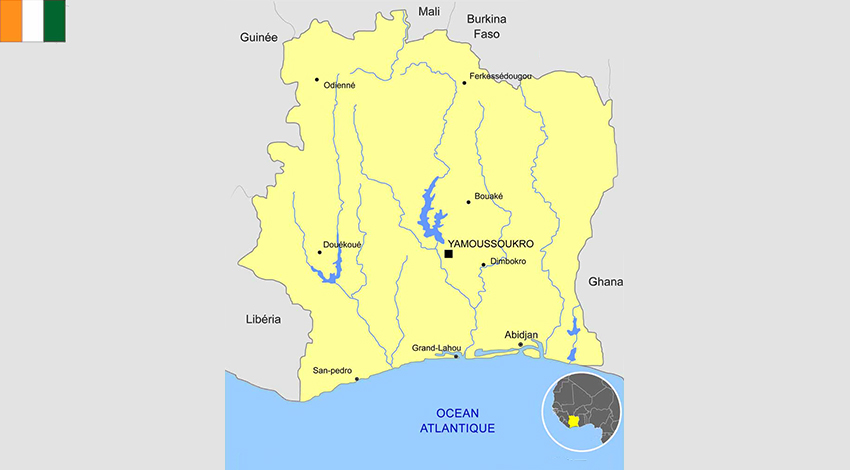
1.1 Political and geographical characteristics of Ivory Coast
Close ties with France after independence in 1960, the development of cocoa for export and foreign investment have all made Côte d'Ivoire one of the most prosperous countries in West Africa, though not immune to political unrest. In the Ivorian constituency, the President is elected directly by an absolute majority in a popular vote, with two rounds if necessary, for a 5-year term (no term limit). The last election was held on October 25, 2015, and the next will be held in 2020. The Prime Minister is appointed by the President of the Republic.
Note:The 2016 constitution limits mandates to 2 presidential terms from the 2020 election.
- Area : 322.463 km2
- Population growth : 2,3%
- Population : 26,260,582 (July 2018)
- Urban population : 50,8% (2018)
- Density : 81.43 inhabitants/km2
- Official language : French
Ivory Coast is a member of ECOWAS, the West African Monetary Zone with Gambia, Guinea, Ghana, Nigeria and Sierra Leone, and the Mano River with Liberia, Guinea and Sierra Leone.
1.2 Macroeconomic framework
| Classement Doing Business | 122th/190 |
| Note CPIA (policy and institutional assessment) | X,X World Bank classification |
| GDP per capita (2017) | 1541 $ |
| Growth rates | 7.8% (2017 est.) |
| Inflation | 0.8 (2017 est.) |
Sources : https://www.cia.gov – http://documents.worldbank.org

Main exports
Cocoa, coffee, wood, oil, cotton, banana, pineapple, palm oil, fish
Human Development and Infrastructure

61.1 years old
Life experience (2018)

43,6%
Poverty line population

81,9%
(total population) Access to water

62,6/1000
(2018 est.) Infant mortality

41,1
Distribution of family income GNI coefficient

26%
Access to electricity

21,1%
Malnutrition (total population)

43,1%
Adult literacy

131%
Cell phone access
1.3 Ivory Coast economic performance and outlook
Real GDP growth is estimated to have reached 7.4% in 2018, up from 7.7% in 2017, supported by external demand for agricultural and petroleum products and increased domestic demand resulting from major investment projects and household consumption. The economy had to cope with several shocks in 2017, including a sharp drop in cocoa prices, a rise in oil prices and social tensions. As a result, the budget deficit widened to 4.2% of GDP before improving to an estimated 3.8% in 2018. Public debt increased to 48.2% of GDP in 2018, driven by Eurobond issues in 2017 and 2018. The risk of overindebtedness remains moderate. Inflation was low, at an estimated 0.5% in 2018, compared with 1.0% in 2017. The current account deficit widened from 1.8% of GDP in 2017 to 2.7% in 2018.
The economic outlook remains favorable, with real GDP growth of 7.0% in 2019 and 6.9% in 2020. A good performance in the agricultural sector will keep inflation below the 3% convergence threshold for the West African Economic and Monetary Union (WAEMU). The current account deficit should stabilize at 2.8% in 2019, thanks to sustained imports of capital goods linked to infrastructure projects.
The economy remains vulnerable to external shocks, such as unfavorable commodity prices (mainly cocoa and oil) and adverse weather conditions. Another urgent challenge is to pursue economic growth and ensure a more balanced distribution between sectors, with a view to achieving a structural transformation of the economy. To achieve this, we need to improve the quality of agricultural products and modernize the industrial sector with a view to higher value-added, job-creating activities.
Outlook: positive and negative factors
Ivory Coast has implemented numerous reforms as part of its National Development Plan 2016-2020. In the energy sector, reforms have focused on the financial sustainability of the sector, clearing the arrears of independent producers and investing in production capacity. As a result, installed capacity increased by 56% between 2011 and 2018 to reach 2,200 M W. Rural electricity coverage has also risen from 33% to 54% of the rural population. In the agricultural sector, reforms have focused on accelerating the development of value chains and increasing local processing of key agricultural products, including cocoa, cashew nuts, palm oil and rubber. Investment has also improved the quality of, and access to, basic education and health services. But reducing poverty and inequality remains a challenge.
Ivory Coast is a member of most of the continental institutions responsible for regional integration. Historically, the country has always been a major immigration destination, and remains at the center of one of the continent's most dynamic migration routes. Ivory Coast is also an important transit corridor for its landlocked neighbors, thanks to its ports of Abidjan and San Pedro. It is a key partner in the regional electricity market, and part of an electricity interconnection network with Benin, Burkina Faso, Ghana, Togo and soon Mali, as well as with the Mano River Union countries (Guinea, Liberia and Sierra Leone). Ivory Coast is the main player in the WAEMU financial markets, and hosts the regional stock exchange. It has also stepped up its investment in energy, road and air infrastructure, as well as regional telecommunications networks.
1.4 The business environment / Ease of Doing Business

Note: The Ease of Doing Business score tracks the gap between each economy and the best performance for each indicator, across all economies measured by Doing Business since 2005. An economy's Ease of Doing Business score is presented on a scale of 0 to 100, where 0 represents the lowest performance and 100 represents the best performance. The ease of doing business ranking ranges from 1 to 190.
Source : http://www.doingbusiness.org
- Benin (capital: Porto-Novo)
- Burkina Faso (capital: Ouagadougou)
- Cape-Verde (capital: Praia)
- Ivory Coast (capital: Abidjan)
- Gambia (capital: Banjul)
- Ghana (capital: Accra)
- Guinea (capital: Conakry)
- Guinea Bissau (capital: Bissau)
- Liberia (capital: Monrovia)
- Niger (capital: Niamey)
- Nigeria (capital: Abuja)
- Senegal (capital: Dakar)
- Sierra Leone (capital: Freetown)
- Togo (capital: Lomé)
Sectors of activity

Agro-industry

Health

Energy



